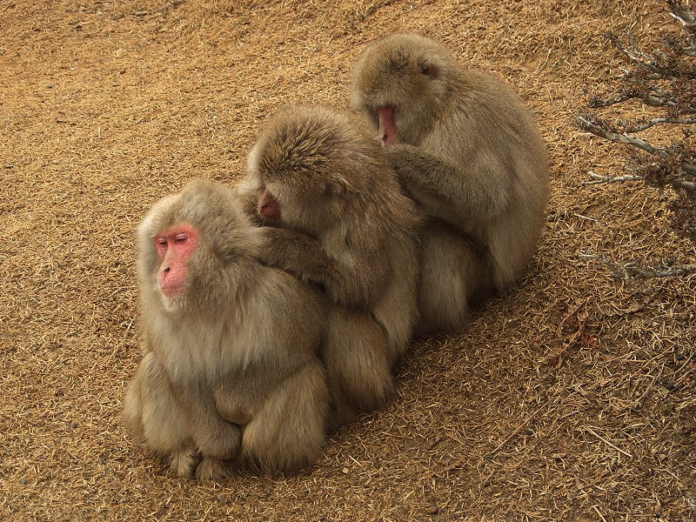Decoding the Animal Communication Signals with the help of AI
Animal communication
Key points
- Communication is when one animal transmits information to another animal causing some kind of change in the animal that gets the information.
- Communication is usually between animals of a single species, but it can also happen between two animals of different species.
- Animals communicate using signals, which can include visual; auditory, or sound-based; chemical, involving pheromones; or tactile, touch-based, cues.
- Communication behaviors can help animals find mates, establish dominance, defend territory, coordinate group behavior, and care for young.
Introduction
Have you ever wondered how ants follow what seem to be invisible trails leading to food? Why male dogs mark their territory by peeing on bushes and lampposts when you take them for a walk? What birds are saying to one another when they chirp outside your window?
If so, you’re in the right place! In this article, we’ll take a look at these—and many other—forms of communication used in the animal kingdom.
Communication takes many forms
Communication—when we’re talking about animal behavior—can be any process where information is passed from one animal to another causing a change or response in the receiving animal.
Can communication happen by accident?
Communication most often happens between members of a species, though it can also take place between different species. For instance, your dog may bark at you to ask for a treat! Some species are very social, living in groups and interacting all the time; communication is essential for keeping these groups cohesive and organized. However, even animals that are relative loners usually have to communicate at least a little, if only to find a mate.
What forms can communication behaviors take? Well, animal sensory systems vary quite a great deal. For instance, a dog’s sense of smell is 40 times more acute than ours! Because of this sensory diversity, different animals communicate using a wide range of stimuli, known collectively as signals.
Below are some common types of signals:
- Pheromones—chemicals
- Auditory cues—sounds
- Visual cues
- Tactile cues—touch
In some cases, signals can even be electric!
Where does this diversity of communication behaviors come from? Like other traits, communication behaviors—and/or the capacity for learning these behaviors—arise through natural selection. Heritable communication behaviors that increase an organism’s likelihood of surviving and reproducing will tend to persist and become common in a population or species.
In the rest of the article, we’ll look at some examples of the many ways that animals can communicate with one another.
Pheromones
A pheromone is a secreted chemical signal used to trigger a response in another individual of the same species. Pheromones are especially common among social insects, such as ants and bees. Pheromones may attract the opposite sex, raise an alarm, mark a food trail, or trigger other, more complex behaviors.

The diagram below shows pheromone trails laid down by ants to direct others in the colony to sources of food. When a food source is rich, ants will deposit pheromone on both the outgoing and return legs of their trip, building up the trail and attracting more ants. When the food source is about to run out, the ants will stop adding pheromone on the way back, letting the trail fade out .
The diagram has an ant hill with 3 small images near it. The image on the left has a row of bright red dots leading to it, and 6 ants moving towards the image. The image on the right has 5 lighter colored dots and 1 ant from the ant hill and 2 ants from a different direction moving towards the image. The image in the center has 5 very faint red dots spaced further apart than the other dots and there is 1 ant moving from the ant hill and 1 moving from a different direction, both towards the image.
Ants also use pheromones to communicate their social status, or role, in the colony, and ants of different “castes” may respond differently to the same pheromone signals . A squashed ant will also release a burst of pheromones that warns nearby ants of danger—and may incite them to swarm and sting .
Dogs also communicate using pheromones. They sniff each other to collect this chemical information, and many of the chemicals are also released in their urine. By peeing on a bush or post, a dog leaves a mark of its identity that can be read by other passing dogs and may stake its claim to nearby territory .
Auditory signals
Auditory communication—communication based on sound—is widely used in the animal kingdom.
Auditory communication is particularly important in birds, who use sounds to convey warnings, attract mates, defend territories, and coordinate group behaviors. Some birds also produce birdsong, vocalizations that are relatively long and melodic and tend to be similar among the members of a species.

A photograph of a barn swallow with its beak wide open.
Many non-bird species also communicate using sound:
- Monkeys cry out a warning when a predator is near, giving the other members of the troop a chance to escape. Vervet monkeys even have different calls to indicate different predators.
- Bullfrogs croak to attract female frogs as mates. In some frog species, the sounds can be heard up to a mile away!
- Gibbons use calls to mark their territory, keeping potential competitors away. A paired male and female, and even their offspring, may make the calls together.
Water, like air, can carry sound waves, and marine animals also use sound to communicate. Dolphins, for instance, produce various noises—including whistles, chirps, and clicks—and arrange them in complex patterns. The idea that this might represent a form of language is intriguing but controversial .
Visual signals
Visual communication involves signals that can be seen. Examples of these signals include gestures, facial expressions, body postures, and coloration.
Gesture and posture are widely used visual signals. For instance, chimpanzees communicate a threat by raising their arms, slapping the ground, or staring directly at another chimpanzee. Gestures and postures are commonly used in mating rituals and may place other signals—such as bright coloring—on display.
Facial expressions are also used to convey information in some species. For instance, what is known as the fear grin—shown on the face of the young chimpanzee below—signals submission. This expression is used by young chimpanzees when approaching a dominant male in their troop to indicate they accept the male’s dominance.
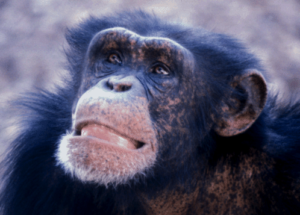
A photograph of a chimpanzee with a fear grin expression on its face.
Changes in coloration also serve as visual signals. For instance, in some species of monkeys, the skin around a female’s reproductive organs becomes brightly colored when the female is in the fertile stage of her reproductive cycle. The color change signals that the female can be approached by suitors.
An organism’s general coloration—rather than a change in color—may also act as a visual signal . For instance, the bright coloration of some toxic species, such as the poison dart frog, acts as a do-not-eat warning signal to predators.

A photograph of a poison dart frog. The frog’s legs are blue, and the body has a stripped orange and black appearance.
Tactile signals—touch
Tactile signals are more limited in range than the other types of signals, as two organisms must be right next to each other in order to touch . Still, these signals are an important part of the communication repertoire of many species.
Tactile signals are fairly common in insects. For instance, a honeybee forager that’s found a food source will perform an intricate series of motions called a waggle dance to indicate the location of the food. Since this dance is done in darkness inside the nest, the other bees interpret it largely through touch .
Tactile signals also play an important role in social relationships. For instance, in many primate species, members of a group will groom one another—removing parasites and performing other hygiene tasks . This largely tactile behavior reinforces cooperation and social bonds among group members .
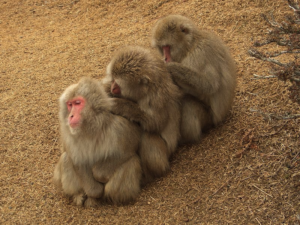
A photograph of 3 baboons sitting in a row grooming each other.
Tactile stimuli also play a role in the survival of very young organisms. For instance, newborn puppies will instinctively knead at their mother’s mammary glands, causing the release of the hormone oxytocin and production of milk .
What is communication used for?
As the examples above illustrate, animals communicate using many different types of signals, and they also use these signals in a wide range of contexts. Here are some of the most common functions of communication:
- Obtaining mates. Many animals have elaborate communication behaviors surrounding mating, which may involve attracting a mate or competing with other potential suitors for access to mates.
- Establishing dominance or defending territory. In many species, communication behaviors are important in establishing dominance in a social hierarchy or defending territory.
- Coordinating group behaviors. In social species, communication is key in coordinating the activities of the group, such as food acquisition and defense, and in maintaining group cohesion.
- Caring for young. Among species that provide parental care to offspring, communication coordinates parent and offspring behaviors to help ensure that the offspring will survive.
As these examples show, communication helps organisms interact to carry out basic life functions, such as surviving, obtaining mates, and caring for young.
How Do Animals Communicate: 4 Types of Animals are fascinating creatures. They could be our loyal companions if we provide them with care and attention. The first key to maintaining a healthy relationship with the animals is understanding them and communicating with them effectively. Now you might ask how we are going to communicate with something that does not speak? Well, you can do that in their way. Firstly, you need to understand their behaviour. Only after that you can communicate with them in their own language.
How Do Animals Communicate?
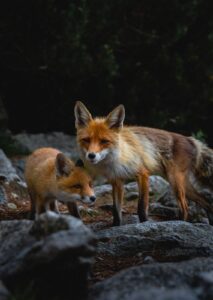
Animal communication is pretty much the same as human communication. The same old process of passing information to one another or the whole group results in a response or some change. As humans, there is sender, receiver and feedback involved. The only difference you can find is that you speak with proper words while they speak through using different methods of communication. There are 4 common types of animal communication that animals use to express themselves, which are:
- Auditory communication involving sound
- Visual communication involving gesture, posture, etc.
- Tactile communication involving touch
- Chemical communication involving pheromone
Usually, animal communication occurs between the same members of a species, but it can also take place between different species. Of course, humans and pets are common examples of that. Some animals are very social and expressive, while some could be extremely lone, communicating only among their own members of species. Some animal species rely on one method of the methods mentioned above to communicate with each other, while some species use more than just one. Interesting facts about animals are that they use communication to express their affection, warn off of threats, or attract a mate.
Auditory Communication

Have you ever wondered how animals communicate with sound? When we talk about animal communication, the first thing that probably comes to your mind, which you are sure of, must be noises and sound. Growing up, even if you don’t know anything about animals, you must have woken up to the chirping of the birds. That’s called auditory communication.
Why do birds chirp you awake? Do they have enmity with you? No! The birds are communicating among themselves and having the time of their life. Another example of auditory communication is the ‘meow’ of the passing cat or the woof of the neighbour’s dog. They are expressing themselves either their satisfaction or dissatisfaction. Only they know the best.
Animals use sounds to express their feelings. When a pet owner provides some food to his dog and the dog barks, that means the dog is happy. Similarly, when a lion growls at a hunter, that means the lion is warning the hunter. Some animals use sounds to alarm their buddies about the approaching danger, while some use them to impress their mates. When a bird sings, usually it’s for his mate or to teach his baby birds. Merian animal Humpback Whale also communicates through sound. Its songs can be heard in some parts of the ocean for miles.
Some animals don’t have vocal organs but rather have complex auditory communication methods. Insects like cicadas, mosquitos, tenrecs etcs. Relays on their body parts to create auditory communication methods.

Do all animals use sound to communicate?
Not all animals communicate with sound, even though auditory communication might seem to be one of the most basic forms of communication. You can take the species of marine animals and a few species of insects as an example.
Visual communication

Visual communication in animals is based on visible signals. These visible signals could include gestures, postures, facial expressions, colouration, camouflaging, etc. Few of these visual communication forms might not seem obvious at first glance, but with close inspection, you will be able to understand them.
Gestures and postures are the most commonly used visual communication for animals. You can see animals doing body movements such as raising hands, flicking feathers, shrinking, slapping the ground, slow body language, eye contact, etc., to attract their fellow mates’ attention, to ward off danger, for playtime or hunting. As for facial signals, the most common example you will find is of a young chimpanzee. They grin at an approaching dominant male of their species to show their acceptance of the male’s dominance. The grin is known as the fear grin.
Another visual signal seen in animal communication is the change in colouration. The change can occur in a single part of their body that had no colour beforehand, like the female monkeys in heat or the existing shade of the body part like a poison dart frog. The reason behind such changes is mostly due to warding off approaching danger or going into heat.
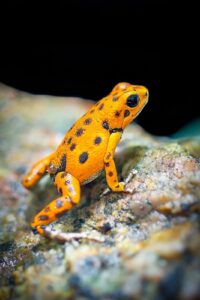
Camouflaging is also a form of visual communication. Camouflaging includes an animal changing its appearance to resemble something else to deceive the onlookers and hide from predators or prey. It communicates through camouflaging that there is nothing to see at all. There are a few insects that can turn their look into leaves, frogs into moss, a species of snakes, and even marine birds too.
What animals communicate visually?
The answer, in general, would be every species that hunts or goes through heat. Common animals who usually communicate through the visual method are dogs, cats, chimpanzees, species of female monkeys, poison dart frogs, wasps, snakes, blue-ringed octopus, giraffes, birds, peacock spiders, penguins, and many more.
Tactile Communication
Tactile communication is said to be the most common form of animal communication. Tactile communication requires touching and the participants to be nearby. Animals usually prefer to stay in groups which put limitations on tactile communication. It’s safe to say tactile communication happens between the same group of species, but it’s not rare among different groups of species. You can look at the zoo animals or pet houses where cats and dogs live side by side.
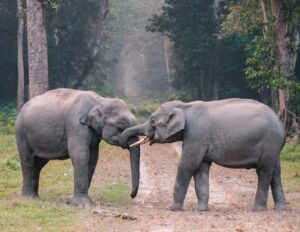
Tactile communication is called a common form of animal communication due to mating reasons. That way, tactile communication definitely occurs among every species of animal that goes through heat. Meanwhile, it is also recognized as a form of social bonding, infant care, grooming, or showcase of dominance. You can take a look at monkeys and apes who love to pick bugs off each other to display affection.
Chemical Communication
Chemical communication is animal communication where the animals leave behind pheromones in the environment for different reasons. Pheromones are the chemical substance produced and released by animals that affect the behaviour or psychology of other animals of their own species. It’s mostly seen among ants and bees. There are different types of pheromones seen in animals – releaser pheromones, primer pheromones, alarm pheromones, food trail pheromones, and sex pheromones.

Releaser pheromones are released for immediate or alteration of behaviour to trigger a response from the same member of the species. It is generally used to attract mates from a distance of two-mile or more. This type of pheromone may elicit a rapid response but is quickly degraded. A primer pheromone causes physiological changes which last longer with a delayed effect. Alarm pheromones are released by an organism in the face of danger to warn or alert the other members of its species. Food trail pheromones are produced to lead the members of their own species towards a food source, while creating a territorial mark in the form of an allomone. Lastly, Sex pheromones are released by an organism to attract an individual of its own species to encourage them for mating or other function related to sexual reproduction.
Animal pheromones are generally released in their urine. These chemical substances are very specific and effective for the day and the night. Pheromones have the potential for lasting for a long time, but it also depends on the weather effects such as rain.
How do animals communicate to humans?

The most common forms of communication between humans and animals are auditory, tactile, and visual. The earlier example of a dog barking at his owner to express his happiness for receiving food is an auditory form of communication. Besides, when your pet whines for your attention or growls to express dissatisfaction and when you play with them or instruct them with something and receive their response – these are all auditory communication methods. Tactile communication occurs when your pet licks you or when you scratch their fur that emits a purr out of them – these are known as tactile methods of communication. As for visual communication, when you train your pet by mimicking a motion or displaying a movement on either posters, books, or phones – that’s called visual communication.
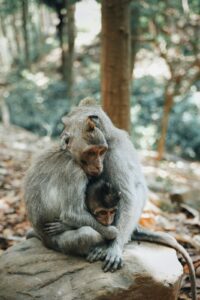
There are about 8.7 million of the total number of species in this world.
Just like humans, animals also have their own world. It’s fascinating to know how similar yet so different they all are.
Now, we can decode animal language with AI
For years, artificial intelligence (AI) and machine learning has been used to analyze and translate human languages. This field of research has helped expand human communication channels as well as led to new language-based technologies like advanced chatbots and voice command smart devices.
Today, AI is being used to study animal communication, with researchers aiming to decipher animal languages in support of conservation and sustainability efforts.
Most animals communicate using visual, auditory, tactile, or chemical signals, and many species have specific preferences in their communication form.
Humans have developed many ways of communicating, with gestures, facial expressions, letters, sounds, visualization, etc. Similar to humans, animals also have diverse forms of communication. Most animals communicate using visual, auditory, tactile, or chemical signals, and many species have specific preferences in their communication form. The study of human-animal communication has stemmed from laboratory and psychological research conducted to understand the behaviors of animals and their means of communication.
Human-animal communication is the interactions observed between humans and other animals, ranging from nonverbal cues and voices to the use of language. For example, interactions between pets and their owners reflect a form of verbal communication. A dog can pick up on a message by interpreting cues such as the owner’s tone of voice and body language. This communication is two-way. For instance, owners can learn to tell the subtle difference between the barking tone of dogs performing different tasks.
Understanding animals with AI
A behavioral ecologist at the University of St Andrews in Scotland studied the capability of a crow. He observed what birds can do and wondered if other overlooked animal capacities might exist. The crows live in complex social groups and may pass toolmaking techniques on to their offspring.
New technology powered by AI is posed to provide these kinds of insights. Whether animals communicate with one another in terms we might be able to understand is a question of enduring fascination. Although people in many Indigenous cultures have long believed that animals can intentionally communicate, Western scientists have traditionally shied away from research that blurs the lines between humans and other animals for fear of being accused of anthropomorphism.
However, according to Rutz, with recent breakthroughs in AI, people realize that we are on the brink of fairly major advances in regard to understanding animals’ communicative behaviour.
Aza Raskin, one of the founders of the nonprofit Earth Species Project, found that Machine Learning may soon make it possible to decipher things like crow calls. Their team of AI scientists, biologists and conservation experts is collecting a wide range of data from various species and building ML models to analyze them.
Other groups, such as the Project Cetacean Translation Initiative (CETI), focus on trying to understand a particular species, the sperm whale. From his findings, Raskin stated that AI and ML tools will change how humans see themselves in relation to everything.
Many animals use different modes of communication. Any actions made before, during or after uttering sounds could provide important context for understanding what an animal is trying to convey. Research catalogued these behaviors in a list known as ethogram. A model found previously unrecognized differences in Zebra Finch songs that females pay attention to when choosing mates. Females prefer partners that sing like the birds the females grew up with.
An AI-powered analysis with Merlin, a free app from the Cornell Lab of Ornithology that identifies bird species. The model is trained on Cornell’s audio library, against which it compares the user’s recording to predict the species identification.
The Role of AI in Translating Animal Communication
The advent of artificial intelligence has opened up new possibilities for understanding and interpreting animal communication. The complexity of animal communication, which often involves a combination of vocal, visual, and chemical signals, presents a significant challenge. However, AI, with its ability to process vast amounts of data and detect patterns beyond human capabilities, offers a promising solution.
Machine learning, a subset of AI, is particularly well-suited to this task. Machine learning algorithms can be trained on large datasets of animal sounds or behaviors, learning to recognize patterns and make predictions based on these patterns. For example, the Koko project, which used machine learning to analyze and interpret the gestures of Koko the gorilla, demonstrated the potential of AI in this field. The project’s success in interpreting Koko’s sign language has paved the way for similar applications in understanding other forms of animal communication.
Natural language processing (NLP), another branch of AI, also holds promise. NLP techniques, traditionally used to analyze human language, can be adapted to analyze animal communication. For instance, the Dolphin Communication Project has been using AI and machine learning to decode dolphin sounds, with promising initial results. The project’s AI system has been able to identify specific dolphin clicks and whistles, bringing us one step closer to understanding these complex creatures.
AI’s role in translating animal communication is not limited to understanding individual species. A recent study published in Nature has used AI to analyze the communication of multiple bird species simultaneously. This multi-species approach, made possible by AI’s ability to process large and complex datasets, could provide new insights into the ecological dynamics and interspecies interactions.
However, it’s important to note that while AI offers exciting possibilities, it is not a magic bullet. The translation of animal communication is a complex task that requires a deep understanding of the specific context and nuances of each animal’s communication system. AI can provide valuable tools and insights, but it is only one piece of the puzzle.
In conclusion, AI is playing an increasingly important role in our quest to understand and translate animal communication. Through machine learning and natural language processing, we are beginning to decode the complex signals that animals use to communicate, opening up new possibilities for interspecies understanding and conservation efforts. As we continue to refine these technologies and deepen our understanding of animal communication, we may one day be able to truly ‘talk’ with the animals.
Case Studies: Translating the Language of the Animal Kingdom
Case Study 1: Translating Primate Communication
In a study conducted by researchers at the University of St Andrews, they developed an AI model to decode the gestural communication of bonobos, a species of primate closely related to humans. The researchers recorded and analyzed over 1,500 instances of bonobo gestures, categorizing them into different types based on the responses they elicited. The AI model was then trained on this dataset, learning to predict the meaning of different gestures based on the context in which they were used. This study represents a significant step forward in our understanding of primate communication, and the methods used could potentially be applied to other species as well.
Case Study 2: Decoding the Language of Whales
The complexity of whale communication has long fascinated scientists. A project called “Whale Talk” is using AI to analyze and interpret the songs of humpback whales. The project, led by a team of researchers at the University of Queensland, involves the use of machine learning algorithms to analyze audio recordings of whale songs. The AI is trained to recognize patterns in the songs and to categorize different sounds, which could potentially lead to a better understanding of whale communication. While the project is still in its early stages, it represents a promising application of AI in the field of animal communication.
Case Study 3: Understanding Bird Songs
Birdsong has been a subject of scientific study for decades, but the complexity and variety of these vocalizations make them difficult to analyze. However, a team of researchers at the University of California, Berkeley, has developed an AI tool that can decode the songs of the Bengalese finch. The tool uses machine learning algorithms to analyze the birds’ songs and identify patterns. This research could provide insights into how birds learn to sing and how they use song in social interactions.
Case Study 4: Interpreting the Communication of Dolphins
Dolphins are known for their complex vocalizations, but interpreting these sounds has proven challenging. A project called “Dolphin Communication Project” is using AI to analyze dolphin sounds and attempt to decode their meaning. The project uses machine learning algorithms to categorize different dolphin sounds and analyze their context. While the project is still ongoing, it represents a significant step towards understanding dolphin communication.
The Impact of AI on Animal Communication Research
The advent of artificial intelligence has revolutionized numerous fields, and the study of animal communication is no exception. AI’s ability to process and analyze vast amounts of data has opened up new avenues for understanding the complex communication systems of various animal species.
AI has significantly changed the field of animal communication research by providing tools that can handle the complexity and volume of data involved. For instance, machine learning algorithms can sift through thousands of hours of audio recordings, identifying and categorizing animal sounds with a precision that far surpasses human capabilities. This has led to breakthroughs in understanding the communication systems of various species, such as the intricate song patterns of birds and the complex vocalizations of dolphins and whales.
The potential for future discoveries in this field is immense. With the continual advancement of AI technologies, researchers will be able to delve deeper into the intricacies of animal communication. For example, the application of deep learning algorithms could potentially decode the semantic content of animal vocalizations, providing insights into the thoughts and emotions of animals.
However, the use of AI in animal communication research also brings about ethical considerations. As we develop technologies that allow us to understand animals better, we must ensure that this knowledge is used responsibly. We must respect the rights and welfare of the animals we study and avoid causing them undue stress or harm. Furthermore, as we gain a deeper understanding of animal communication, we must consider the implications of this knowledge. For instance, if we can decode animal languages, should we attempt to communicate with them? And if so, how should this communication be conducted?
In conclusion, AI has had a profound impact on animal communication research, offering new tools for understanding the complex languages of different species. However, as we continue to explore this exciting frontier, it is crucial that we do so with respect for the animals we study and a thoughtful consideration of the ethical implications of our work.
Future Directions: AI and Animal Communication
As we look towards the future, the potential for advancements in AI and animal communication is vast and exciting. The intersection of these two fields promises to revolutionize not only how we understand our fellow creatures but also how we interact with and protect them.
One of the most promising areas of future development lies in the realm of conservation. AI has the potential to play a significant role in conservation efforts, particularly in monitoring and protecting endangered species. For instance, AI algorithms can be trained to recognize the calls of specific animals, allowing for more effective tracking of populations and better understanding of their behaviors. This could lead to more effective conservation strategies and a more sustainable coexistence with our planet’s diverse species.
Moreover, the role of AI professionals in this field cannot be overstated. As the demand for sophisticated AI tools increases, so too does the need for professionals who can develop and implement these technologies. AI professionals will be at the forefront of creating innovative solutions to the complex problem of animal communication, driving the field forward and opening up new avenues of research and understanding.
In the realm of animal communication, AI has already shown its potential in several case studies. For instance, a team of researchers from the University of Plymouth used machine learning algorithms to analyze the communication patterns of dolphins, leading to new insights into their social structures and behaviors. Similarly, a study published in the journal “Science Advances” demonstrated how AI can be used to decode the complex songs of birds, providing a deeper understanding of their communication and mating behaviors.
However, as we move forward, it is crucial to consider the ethical implications of this research. While the potential benefits are substantial, we must also consider the impact on the animals themselves. It is essential to ensure that our pursuit of knowledge does not harm the very creatures we seek to understand. This includes considering the potential stress caused by monitoring equipment, the impact of human interference on animal behaviors, and the importance of respecting the autonomy and privacy of these creatures.
In conclusion, the future of AI in animal communication research is bright, filled with potential for groundbreaking discoveries and transformative applications. As we continue to explore this exciting frontier, it is our responsibility as AI professionals, researchers, and stewards of our planet to ensure that our work is conducted ethically and sustainably, always with the welfare of our fellow creatures in mind.
Conclusion: The Dawn of a New Era in Animal Communication
As we stand on the precipice of a new era in animal communication research, the role of artificial intelligence cannot be overstated. The marriage of AI and animal communication has already begun to yield fascinating insights into the complex languages of our fellow creatures, from the intricate songs of birds to the sophisticated gestures of primates.
The application of AI in this field has not only enhanced our understanding of animal communication but also opened up new possibilities for conservation efforts. By decoding the languages of various species, we can gain a deeper understanding of their behaviors, social structures, and needs, enabling us to develop more effective strategies for their protection.
Looking towards the future, the potential for further advancements in this field is vast. As AI technologies continue to evolve and improve, so too will our ability to decipher the complex languages of the animal kingdom. However, as we venture further into this exciting frontier, it is crucial that we do so with a deep respect for the animals we study and a commitment to conducting our research ethically and sustainably.
In conclusion, the intersection of AI and animal communication represents a new frontier in our understanding of the natural world. As we continue to explore this exciting field, we stand to not only gain new insights into the languages of our fellow creatures but also to deepen our connection with the rich tapestry of life that shares our planet. The journey is just beginning, and the future holds promise of many fascinating discoveries to come.
Compiled & Shared by- This paper is a compilation of groupwork provided by the Team, LITD (Livestock Institute of Training & Development)
Image-Courtesy-Google
Reference-On Request


